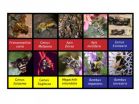(Press-News.org) CHAMPAIGN, Ill. — Most people have trouble telling them apart, but bumble bees, honey bees, stingless bees and solitary bees have home lives that are as different from one another as a monarch's palace is from a hippie commune or a hermit's cabin in the woods. A new study of these bees offers a first look at the genetic underpinnings of their differences in lifestyle.
The study focuses on the evolution of "eusociality," a system of collective living in which most members of a female-centric colony forego their reproductive rights and instead devote themselves to specialized tasks – such as hunting for food, defending the nest or caring for the young – that enhance the survival of the group. The study appears in the Proceedings of the National Academy of Sciences.
Eusociality is a rarity in the animal world, said Gene Robinson, a University of Illinois entomology professor and the director of the Institute for Genomic Biology, who led the study. Ants, termites, some bees and wasps, a few other arthropods and a couple of mole rat species are the only animals known to be eusocial.
Among bees, there are the "highly eusocial" honey bees and stingless bees, with a caste of sterile workers and a queen that functions primarily as a "giant, egg-laying machine," Robinson said. And there are other, so-called "primitively eusocial" insects, usually involving a single mom who starts a nest from scratch and then, once she has raised enough workers, "kicks back and becomes a queen," he said.
Illinois entomology professor Sydney Cameron, a collaborator on the study and a social insect evolution expert, dislikes the term "primitively eusocial" because it suggests that these bees are on their way to becoming more like stingless bees or honey bees. Eusociality is not a progressive evolution from the "primitive" to the "advanced" stage, she said.
"They're not striving to become highly eusocial," Cameron said. "They don't say to themselves, 'If only I could become a honey bee!' "
"People talk about the evolution of eusociality," Robinson said. "But we want to emphasize that these were independent evolutionary events. And we wanted to trace the independent stories of each."
To accomplish this, the researchers worked with Roche Diagnostic Corp. to sequence active genes (those transcribed for translation into proteins) in nine species of bees representing every lifestyle from the solitary leaf-cutter bee, Megachile rotundata, to the highly eusocial dwarf honey bee, Apis florea. Then Illinois crop sciences professor and co-author Matt Hudson used the only available bee genome, that of the honey bee, Apis mellifera, as a guide to help assemble and identify the sequenced genes in the other species, and the team looked for patterns of genetic change that coincided with the evolution of the differing social systems.
"Are there genes that are unique to the primitively eusocial bees that aren't found in the highly eusocial bees?" Cameron said. "Or if you lump all the eusocial bees together, are there unique genes that unite those groups compared to the solitaries?"
The analysis did find significant differences in gene sequence between the eusocial and solitary bees. The researchers also saw patterns of genetic change unique to either the highly eusocial or primitively eusocial bees. The frequency and pattern of these changes in gene sequence suggest "signatures of accelerated evolution" specific to each type of eusociality, and to eusociality in general, the researchers reported.
"What we find is that there are some genes that show signatures of selection across the different independent evolutions (of eusocial bees)," Robinson said. "They might be representatives of the 'gotta have it' genes if you're going to evolve eusociality. But others are more lineage-specific."
INFORMATION:
This study was made possible with a one-gigabyte sequencing grant from 454 Life Sciences (Roche Diagnostics Corp.) by way of the Roche 1GB contest. The National Science Foundation and the National Institutes of Health also supported the research.
The study team also included researchers from Cornell University and from the Program in Ecology, Evolution and Conservation Biology and the Institute for Genomic Biology at Illinois.
Editor's note: To reach Gene Robinson, call 217-265-0309; email generobi@illinois.edu. To reach Sydney Cameron, call 217-333-2340; email sacamero@illinois.edu.
The paper, "Genes Involved in Convergent Evolution of Eusociality in Bees," is available from the UI News Bureau: news@illinois.edu.
Genetic study offers insight into the social lives of bees
2011-04-12
ELSE PRESS RELEASES FROM THIS DATE:
Intense Peru Entices Travelers to Tour Machu Picchu 100 Years After Its Discovery
2011-04-12
Intense Peru, experts in designing unique travel experiences to Peru, recently announced a 10% savings on all Machu Picchu tours in recognition of the 100 year anniversary of the discovery of Lost City of the Incas by American archaeologist Hiram Bingham. Every year an increasing number of travelers come from different parts of the world to admire the Historic Sanctuary of Machu Picchu. Some travelers have little information and some others not only are well prepared but fill their tour guides with enthusiastic comments and questions. And the truth is that no matter how ...
Protein could improve recovery from heart attacks
2011-04-12
Angiogenesis, the development of new blood vessels, is required during embryonic development and wound healing, as well as during disease processes such as tumor growth. The signals that direct angiogensis are incompletely understood, but could represent novel targets for the development of therapies that promote or inhibit this process.
In this paper, Young-Guen Kwon and colleagues, of Yonsei University in Seoul, Korea, investigated the role of two related proteins- DKK1 and DKK2- in angiogenesis. These proteins are known to have similar functions in inhibiting a particular ...
Physicists discover new way to visualize warped space and time
2011-04-12
PASADENA, Calif.—When black holes slam into each other, the surrounding space and time surge and undulate like a heaving sea during a storm. This warping of space and time is so complicated that physicists haven't been able to understand the details of what goes on—until now.
"We've found ways to visualize warped space-time like never before," says Kip Thorne, Feynman Professor of Theoretical Physics, Emeritus, at the California Institute of Technology (Caltech).
By combining theory with computer simulations, Thorne and his colleagues at Caltech, Cornell University, ...
Potato consumption in children's meals leads to higher overall diet quality
2011-04-12
Denver, CO., April 11, 2011 – Research to be presented this week at The Federation of American Societies for Experimental Biology (FASEB) Conference in Washington, D.C., demonstrates that consumption of white potatoes (non-fried) by children does not displace other vegetables from children's meals. In fact, meals that contain white potatoes contain more servings of other vegetables, and are significantly higher in potassium, fiber and vitamin C. Both potassium and fiber were identified as nutrients of concern in the 2010 Dietary Guidelines, released February 2011.
"Potatoes ...
Pistachios deliver weight management support, heart health benefits
2011-04-12
Washington, D.C., April 11, 2011 – In a first-of-its-kind study with nuts, randomized controlled-feeding research conducted by the Agricultural Research Service (ARS) of the United States Department of Agriculture (USDA) found that fat in pistachios may not be completely absorbed by the body. The findings indicate that pistachios may actually contain fewer calories per serving than originally thought – further validating pistachios as one of the lowest calorie nuts with 160 calories per 30 gram serving (approximately 1 ounce). The study was presented today at the Experimental ...
Glaucoma patients report a wide range of emotional and psychological changes
2011-04-12
Fear of the unknown is one of the greatest issues facing patients with glaucoma - the second leading cause of blindness worldwide after cataracts - according to research in the April issue of the Journal of Advanced Nursing. People also worry about how the eye disease, which can be hereditary, will affect other members of their family.
Researchers spoke to 24 people with glaucoma, which can lead to severe restriction of the visual field and irreversible blindness if it is not detected early enough and successfully treated.
It's estimated that 4.5 million people worldwide ...
Light, chemistry, action -- a new technique to target skin cancers?
2011-04-12
Targeted photodynamic therapy can completely eradicate some models of cancer, according to the latest research by UK and Swiss scientists, published in the current issue of the British Journal of Cancer.
The team – including researchers from the University of Hull and ETH Zurich – linked light-sensitive molecules with antibodies that target tumour blood vessels. When irradiated with light, the molecules create particles known as reactive oxygen species, which in high numbers cause irreparable damage to cells.
By ensuring the light-sensitive molecules were targeted at ...
DirectRooms.com - Performances From International Cultures are Held in Aberdeen
2011-04-12
People that want to learn about the customs of different nations can head to the Aberdeen International Fun Day to see all sorts of activities. Performers will be giving an insight into the music and dance of each of their representative countries and this will include dances from Russia, India, Sweden and China. Attendees can see firsthand the steps of Bhangra dances, take part in a Tai Chi class or even listen to the melodic voices or a Gaelic choir.
The performances are designed to bridge the gap between communities and for people to learn about each other's cultures ...
How do we fight the war against cyber terrorism?
2011-04-12
The Internet has no borders, no universal legislation, and although highly social and distributed is not represented by cooperation across the globe. Given those characteristics how might nations make their plans for counter terrorism in cyberspace as active online as they are in the everyday world? A collaboration between researchers in the US and Iran hoped to address that issue and its findings are published this month in the International Journal of Internet Technology and Secured Transactions.
Incidence of online crime has grown considerably in recent years, with ...
New technique tracks viral infections, aids development of antiviral drugs
2011-04-12
WASHINGTON -- Scientists at the Naval Research Laboratory Center for Bio-Molecular Science and Engineering have developed a method to detect the presence of viruses in cells and to study their growth. Targeting a virus that has ribonucleic acid (RNA) as its genetic makeup, the new technique referred to as locked nucleic acid (LNA) flow cytometry-fluorescence in situ hybridization (flow-FISH), involves the binding of an LNA probe to viral RNA.
While individual parts of the technique have been developed previously, Drs. Kelly Robertson and Eddie Chang, in collaboration ...



